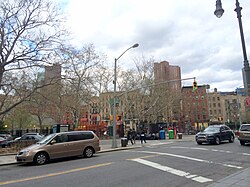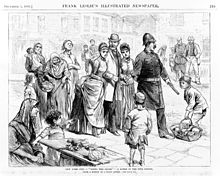Five points
The Five Points were a poor neighborhood in southern Manhattan , New York , in the 19th century that existed between circa 1820 and 1885.
location
The Five Points were at the intersection of Anthony Street (now Worth Street ), Cross Street (now Mosco Street) and Orange Street (now Baxter Street). The name Five Points was derived from the five street corners at this intersection. And the Mulberry Bend , a bend of Mulberry Street , was part of the district.
history
At the location of the quarter was originally the Collect Pond, a pond and fresh water reservoir that was fed by its own spring. When local artisans, firms and butchers then dumped their waste into the Collect Pond, it became a source of infection and disease, necessitating the construction of a canal. After the completion of the canal, after which Canal Street is named, the pond was replenished in 1811, but this made this area of Manhattan even more marshy as there were many natural springs here that had nowhere to drain.
The swampy and insect-infested area subsequently offered cheap land for the large number of immigrants crowding into the city. At that time it was mostly Irish , as the great Irish wave of immigration started in 1820, culminating in the Irish famine (potato famine ) from 1845 to 1849. The Five Points quickly developed into a slum area with a high crime rate.
In 1842 Charles Dickens visited the Five Points and was shocked by the poor living conditions that prevailed here:
“This is the place: these narrow ways diverging to the right and left, and reeking every where with dirt and filth. Such lives as are led here, bear the same fruit here as elsewhere. The coarse and bloated faces at the doors have counterparts at home and all the wide world over. Debauchery has made the very houses prematurely old. See how the rotten beams are tumbling down, and how the patched and broken windows seem to scowl dimly, like eyes that have been hurt in drunken frays. Many of these pigs live here. Do they ever wonder why their masters walk upright in lieu of going on all-fours? and why they talk instead of grunting? "
“This is the place. Those narrow streets that run off to the right and left and stare with dirt and rubbish everywhere. The lives that are led here bear the same fruit as everywhere else. The coarse and bloated faces on the doors have their counterparts at home and all over the world. Debauchery has even aged houses ahead of their time. See how the rotten beams collapse and how the patched and broken panes of glass scowl like eyes that have been injured in drunken brawls. Many of these pigs live here. Do they sometimes wonder why their masters walk upright and not on all fours? And why do they speak instead of grunt? "
In the elections of 1827, Tammany Hall had truckloads of immigrants drive from polling station to polling station, allowing them to vote multiple times. That task was then left to the gangs. The district was ruled by gangs such as The Chichesters , Roach Guards , Plug Uglies , Shirt Tails and Dead Rabbits around 1850 .
Around the middle of the 19th century, there were clashes between immigrants and locals ( natives ). This was one of the starting points for the Draft Riots , a serious civil war-like unrest in 1863 in which at least 120 people were killed. As early as 1834 there had been riots against the liberation of slaves ( anti-abolitionist riots ) and in 1857 the Dead Rabbits Riots .
The cradle of the American form of tap dance was in the Five Points : various ethnic groups held dance competitions here around the middle of the 19th century. The mixture of African shuffle and Irish jig resulted in an independent style.
The slum was closed between 1885 and 1895 and the residents moved to other parts of New York. At the beginning of the 20th century, the Five Points Gang , at that time New York’s most powerful gang, was up to mischief. At their wedding, it had around 1,500 members and ruled an area between Broadway , Bowery , Fourteenth Street and City Hall Park.
present

Today nothing can be seen of the former quarter. In its place, public facilities such as Columbus Park and Collect Pond Park as well as municipal and state administration buildings with the Civic Center were built. The Thurgood Marshall United States Courthouse is located on Foley Square on Center Street . Various New York City correctional facilities are also located on Center Street , where the infamous Tombs Prison once stood, which has housed criminals since 1838. It was in use until 1897 and was located near what is now City Prison Manhattan on White Street . Part of Chinatown is also located on the former site of the Five Points.
Archaeological research

More recently, efforts have been made to shed light on the history of the Five Points in the context of Historical Archeology . In addition to the evaluation of historical sources, archaeological excavations took place in the area of the Foley Square Courthouse in the 1990s , during which more than 850,000 finds came to light. Most of this material was stored in an archaeological laboratory at World Trade Center 6 and was lost in the September 11, 2001 terrorist attacks when the building was destroyed.
Adaptations
- Five Points and the mentioned riots in the middle of the 19th century form the background for the feature film Gangs of New York by Martin Scorsese , which is based on the criminal history book of the same name by Herbert Asbury from 1928. In addition to the feature film, the television documentary "Uncovering the Real Gangs of New York" was made, which deals with the historical background of the film.
- In the feature film Der Clou , set in 1936, one of the protagonists claims to come from the same neighborhood, namely the Five Points, like a gang boss in order to gain their trust.
- The American television series Copper - Justice is brutal , which started in 2012, is about the Irish-American police officer Kevin Corcoran, who served in the Five Points in 1864/65 . Franka Potente plays a brothel owner of German origin.
- Large parts of the plot of Green Blood (GREEN BLOOD- グ リ ー ン ・ ブ ラ ッ ド -), a manga by Masasumi Kakizaki , take place in the Five Points .
See also
Individual evidence
- ^ Edwin G. Burrows, Mike Wallace, Gotham: a history of New York City to 1898. Oxford University Press, New York, Oxford 1999, pp. 542-562.
- ^ JT Headley: The Great Riots of New York, 1712 to 1873. EB Treat, New York 1873, pp. 131-132.
- ↑ Lower East Side History Project ( Memento of the original from September 25, 2013 in the Internet Archive ) Info: The archive link was inserted automatically and has not yet been checked. Please check the original and archive link according to the instructions and then remove this notice. (English).
- ↑ Archaeological finds from the excavations (Engl.) ( Memento of the original March 12, 2016 Internet Archive ) Info: The archive link is automatically inserted and not yet tested. Please check the original and archive link according to the instructions and then remove this notice. from the General Services Administration website , accessed March 5, 2016.
- ↑ Colleen P. Popson: Cultural Loss in Lower Manhattan. Archeology Archive , June 19, 2002, accessed March 5, 2016 .
- ^ Nina Rehfeld: In the streets of New York. In: FAZ.NET . August 11, 2012, accessed December 3, 2012 .
- ↑ carlsen.de Manga Green Blood.
literature
- Rebecca Yamin (Ed.): Tales of Five Points. Working-Class Life in Nineteenth-Century New York. John Milner, West Chester PA 1998.
- Rebecca Yamin (Ed.): Becoming New York. The Five Points Neighborhood. Society for Historical Archeology, Detroit MI et al. 2001, (= Historical archeology 35, 3, ISSN 0440-9213 ).
- Tyler Anbinder: Five Points. The 19th-Century New York City Neighborhood That Invented Tap Dance, Stole Elections, and Became the World's Most Notorious Slum. New York 2001, ISBN 0-684-85995-5 .
- Tyler Anbinder: From Famine to Five Points. Lord Lansdowne's Irish Tenants Encounter North America's Most Notorious Slum. ( Memento of September 28, 2004 on the Internet Archive ) In: American Historical Review. 107, April 2002, ISSN 0002-8762 , pp. 350-387.
Web links
- The Five Points Site - Archaeological Excavations
- The history of Five Points (English)
Coordinates: 40 ° 42 ′ 52 ″ N , 74 ° 0 ′ 1 ″ W.


